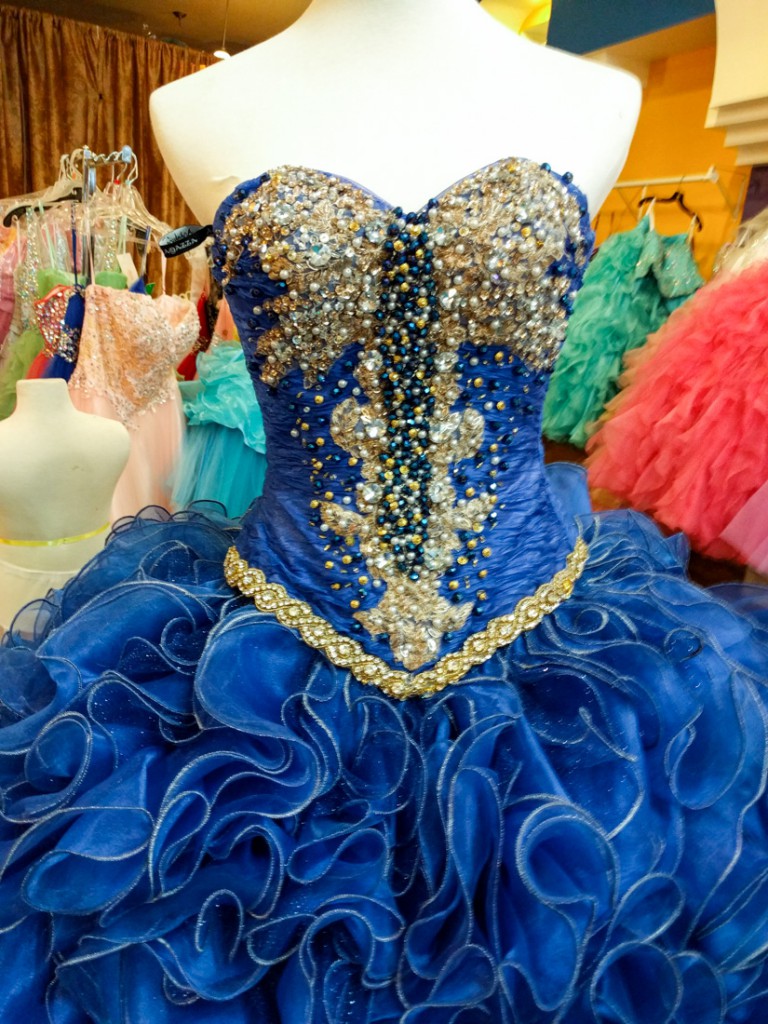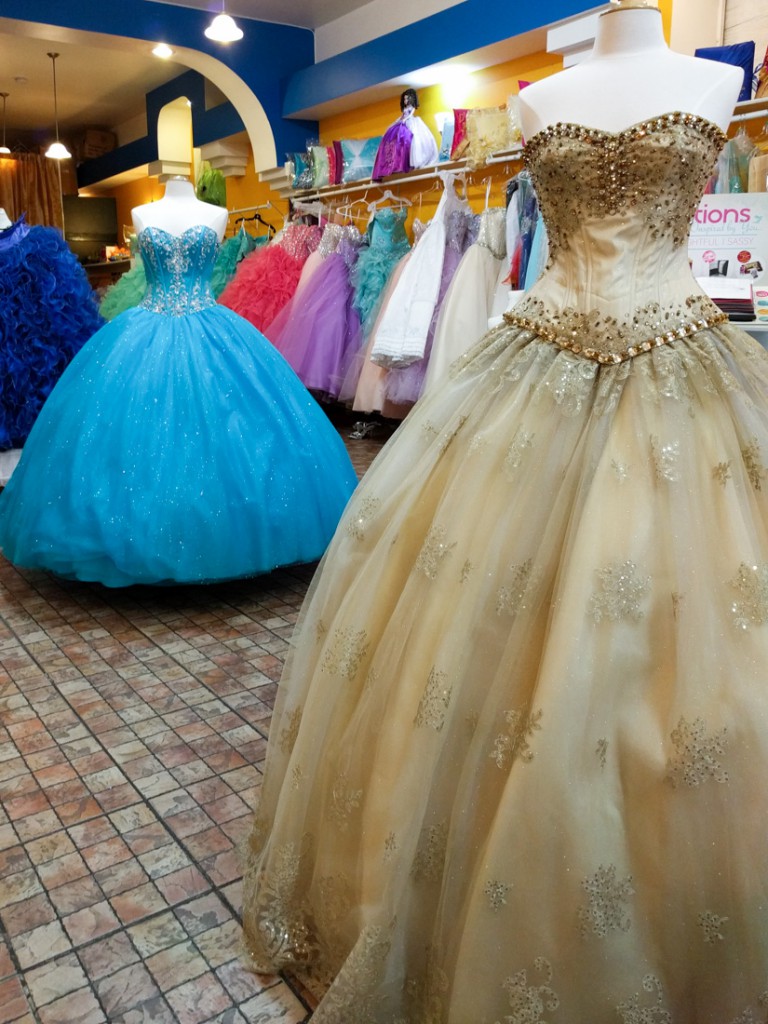By Harry Huggins
Hilda Sanchez sits at her desk with a street view of one of Chicago’s biggest retail corridors. Nearby are three rows of dresses in a rainbow of vibrant colors with skirts that billow out at least two feet from the mannequins that wear them.
Sanchez’s dress shop is one of many lining 26th Street. Their clientele, 15-year-old Hispanic girls, help make 26th Street in Little Village the city’s second Magnificent Mile.
The stores mainly sell dresses worn in coming-of-age celebrations called quinceañeras. In Latino culture, the parties are like bat mitzvahs or sweet sixteens, and the dresses reflect the event as a milestone in the lives of these young girls. The dress Sanchez’s daughter, Jailene, wore for her quinceañera is a perfect example: navy blue, with ornate, silver beading on the top and a royal blue skirt with wavy ruffles. These dresses can come as large as three times the size of the girls wearing them.

“When you see the little girl try on the dress and she starts dancing, then you know it’s a dress that she wants,” Sanchez said.
Sanchez’s daughter, Jailene, remembers spinning around in her royal blue dress in little circles for the whole night of her party.
“I didn’t feel like an adult,” Jailene said. “I was acting like a little girl. But the part where I did feel different was when I was with my family and they were giving their speeches. That’s when I felt like I had more responsibility as a person.”
Why so many?
If you walk the length of the 26th Street business district, starting at Sacramento Avenue and heading west for a mile and a half, you’ll pass 20 stores that sell apparently identical colorful, billowy dresses. It may seem irrational for so many similar shops to operate within sight of each other—imagine if one street had 20 coffee shops in a mile.
These shops, however, benefit from a special economic phenomenon called agglomeration. In some industries, stores will cluster together in tight geographic quarters and feed off collective interest in their goods.
Teresa Gonzales, a professor at Knox College, wrote about 26th Street on the Everyday Sociology blog. She sees how the dress shops increase awareness of the area in the popular consciousness.
“If I’m looking for specific Mexian cultural goods, whether it’s for a quinceañera, a wedding or a baptism, I know I’m going to go to 26th Street,” Gonzales said.
Gonzales explained that the shops’ proximity allows for a special kind of innovation.
“Because we’re all working on similar things, we can have these conversations,” Gonzales said. “We can see what our competitor is doing and say, ‘How are we going to differentiate ourselves?’”
Alan Malter, a marketing professor at the University of Illinois at Chicago, sees a kind of magic in the physical proximity of the shops and their social interactions. The store owners see each other on the street and in social settings around the neighborhood. They informally pass along important information and cooperate with each other more naturally than shops that are more separate.
“There’s a naive notion with the market economy of cutthroat competition. You would expect one dominant seller who would be so much more efficient,” Malter said. “In economies like this, it’s not a zero-sum game. The idea is that if I win, you don’t lose. It can be win-win. We can strengthen each other.”
One major danger in agglomeration economies like 26th Street is isomorphism, when all the stores start to look alike after copying so many of each other’s ideas.
Malter thinks the subtle differences between each dress helps to keep these stores distinctive.
“They have the same kind of stuff, but slightly different: different designers, different price points,” Malter said. “One store probably offers great variety, but collectively, they have unbeatable variety.”

Little Village specifically benefits from a predictably stable demand for the dresses and quinceañera party supplies.
“You have a population where, culturally, these certain goods and items are still relevant and are going to be relevant for a while,” Gonzales said.
The Money
These shops are a huge support for Little Village and the city as a whole. The street brings in more tax revenue than any other street in Chicago except Michigan Avenue. Jaime di Paulo, executive director of the Little Village Chamber of Commerce, estimates that 26th Street brings in $900 million each year.
The success of 26th Street starts at the shops themselves. The cheapest dress Sanchez sells costs $500, and the most expensive cost as much as $1,500.
Beyond the puffy dresses, Sanchez sells similarly expensive dresses for the quinceañera equivalent of bridesmaids, called damas. She sells all the accessories for a quinceañera, too, including tiaras, embroidered pillows, shoes, fake bouquets, glittery invitations.
The stores you need for planning the rest of a quinceañera are all within a few blocks of each other in either direction from Sanchez’s store.
Jose Ramirez has been a photographer with Gabriel Studio for 22 years. His photo packages cost anywhere from $700 to $3,000, and he photographs around 100 parties each year.
“I say to the mothers, from the beginning, they call their daughters ‘my little princess!’” Ramirez said. “When they have the quinceañera, it’s the only day the dream comes true. She becomes a princess.”
The families invest even more in a party’s entertainment. Claudia Villegas works at Pink Noise, a DJ company that provides much more than just DJs. Her basic package—with just a DJ—costs $850. From there, clients can add lights and videos. She said the most expensive Pink Noise package includes a mammoth wall of LED screens.

You can even book limos, caterers and venues at shops along the street. Di Paulo is proud of how 26th Street has become a commercial destination and maintained its identity. He sees people from all around the Midwest and as far away as Florida and Colorado come to Little Village to prepare for a quinceañera.
While families shop for a dress, they eat lunch, pay for parking, send money to family in Mexico, buy specialty groceries and enjoy ice cream flavors they haven’t had since they were children. These businesses employ more than 6,000 people, di Paulo said.
“Kids are turning 15 everyday by the thousands, so that’s what’s driving this business really,” di Paulo said. “We can have all the neighbors we want, but we want to keep our identity in the corridor. That’s why you mainly see only Hispanic-owned businesses.”


